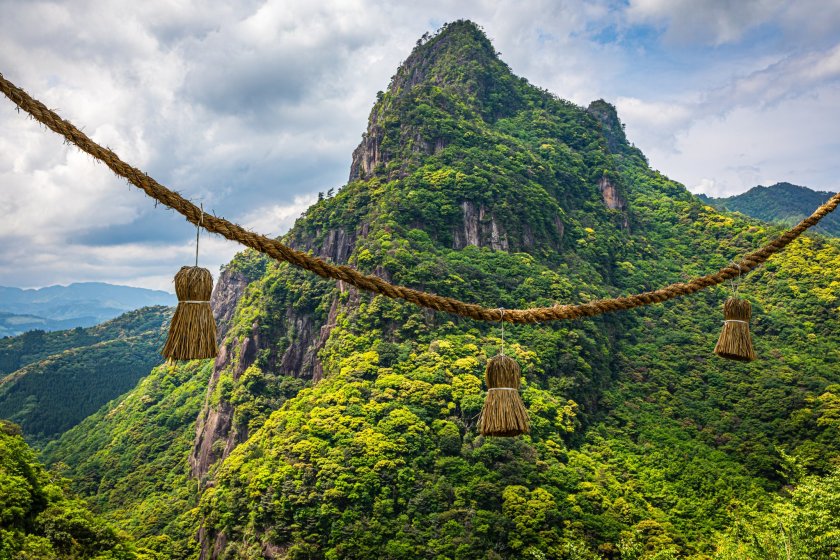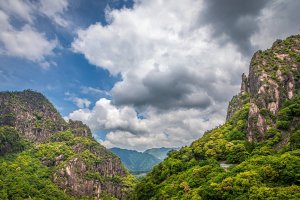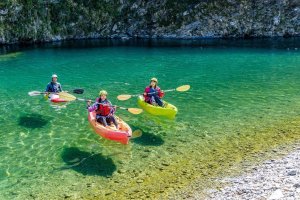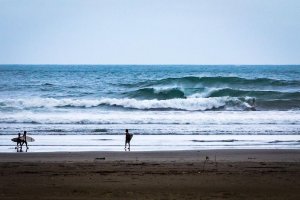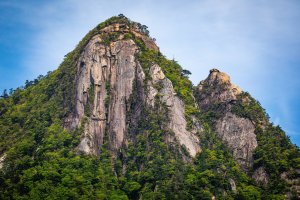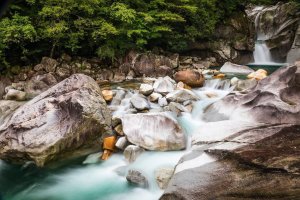Japan is well known for its ultra-modern urban landscapes, but that’s only the half of it.
Of the country’s four main islands, Kyushu is the westernmost, and midway down its Pacific Coast lies Nobeoka. With a population of just over a hundred thousand, the city is large enough to have witnessed history and develop outstanding regional cuisine, yet small enough to remain intimate with its natural surroundings at the foot of majestic mountains and along the confluence of rivers as they flow into the vast ocean.
Nature

The Sobo, Katamuki and Okue Biosphere Reserve, a UNESCO designated area preserving the harmony between nature and human society, covers much of the city limits. Outdoor activities are bountiful here. These mountains draw visitors from overseas and around Japan for trekking and rock climbing, and even a drive through old-growth forests and along the river valleys with their great boulders make birdwatching and catching a glimpse of deer and other forest animals easy.
- Location: The Sobo, Katamuki, and Okue Biosphere Reserve extends from Nobeoka City into parts of Kumamoto and Oita Prefectures.
- More info: The website has extensive information about flora, fauna, highlights, and trails in English, as well as a pamphlet.


Among the mountain streams, the Kogawa (Ko River), famous for its pristine waters that transform in color from cobalt blue to emerald green as the sunlight changes, makes for an exceptional adventure. And as the rivers meet the ocean, this coast of Miyazaki Prefecture boasts scenic drives and cycling courses, superb beaches, and some of the best surfing and coral reefs in Japan. A wide variety of mountain and sea activities are made easy with Nobestar, a local organization providing gear and expert guides.
- Location: Nobestar will pick you up at the Kitagawa Hayuma roadside station.
- More info: SUP experiences run from May to August; canoe experiences run from April to September, see Nobestar’s website for all the year’s outdoor experiences.


If you only hike one mountain in Nobeoka, the dual-peaked Mt. Hoko (Hokodake, 1277 m or 4190 ft) is the choice for most visitors, though one can trek for a full day to multiple peaks and panoramic views or even days though this gorgeous reserve. Along the path, you have a chance to see rare endemic species, such as the Japanese serow (an antelope-like mountain goat) and the purple emperor (the national butterfly of Japan), as well as delicate flowers, hardy decorative grasses, and lush mosses.


The trail to the summit of Mt. Hoko can be circuited in three to four hours and not only passes the largest rock slab in Japan, a granite monolith of 350 m (1150 ft) resembling the blade of a halberd (or hoko in Japanese), but also the fun and photogenic Pac-Man Rock (Pakkun-iwa, named after the iconic video game). The trail can be strenuous, winding over rough boulders, along streams, and up steep ridges where ropes are provided. Hiking boots, layered clothing, and gloves are recommended. Begin your hike at the Shishi River Campground, which has parking, restrooms, a small shop, and a vending machine. You will need to distinguish the kanji characters in order to follow the signs for your intended trail: 鉾岳 Hokodake, 雄鉾 Onboko (“male halberd,” the high peak), and 雌鉾 Menboko (“female halberd,” the lower peak with large rock face).
- Location: The trailhead begins at the excellent Shishi River Campground (map), 80 minutes from downtown by car; budget at least 2 hours to reach the high peak of Mt. Hoko.
- More info: Mountains and Waterfalls (Nobeoka City).



You can also take a shorter hike to the spectacular Mukabaki Falls. The waterfall flows 77 m (253 ft) almost straight down between Mt. Mukabaki’s twin peaks and is recognized as one of Japan’s top 100 waterfalls. The locals call the left and higher peak Odake (male peak, 831 m or 2726 ft) and the right Medake (female peak, 809 m or 2654 ft). It’s a very rocky 40 minutes to the base of the waterfall, and another hour to climb the peak and look down on the falls.
- Location: A 25-minute drive from Nobeoka Station, the trailhead's parking lot (map) is a little past the Hideji Beer Brewery and Mukabaki Shrine.
- More info: Mountains and Waterfalls (Nobeoka City).



North of the city in Jige district, you’ll find one of Japan’s official top 100 villages, known as Chayama. It’s known for green tea, and the views of the hilly tea fields against both the mountains and sea etch in each visitor a memory that is distinctly Japanese. Each field is unique and beautiful. From the Hirokawa Observation Platform, the views are excellent any time of year. Drive back down toward the village and pause at the Jige Chayama observatory for another photo spot on the side of the road. Then, continue your aesthetic drive along narrow roads through fields of Japanese tea.
- Location: Chayama (map) is north of downtown just past Kitaura Interchange; the Haraigawa observation platform (map) and the Chayama observatory (map) are up in the mountains.
- More info: Nobeoka Sightseeing.


Along the coast, Nobeoka has a small but especially photogenic shrine that’s worth visiting. The blue torii of Minato Shrine is one of only four such gates in Japan. The gate stands near downtown at the confluence of the Gokase, Kita, and Hori Rivers, and next to the Ose River, where they all flow into the ocean. A small lighthouse presides over the river mouth. The blue of the torii is the same color as that used to paint the bottom of boats, fitting for a shrine housing deities protective of the sea and its navigators. At the large torii, in an enclosure, are two sacred rocks, one black and one red, in the sand. Walking along the beach, you can explore a lot of large driftwood and shells washed in by the waves. The area near the shrine is also known for birdwatching and fishing from shore.
- Location: Minato Shrine is east of downtown in Tomimachi (map). Pull off to the side of Route 212 here and walk down to the beach.
- More info: Tegeume Marché.
History


Along with the ruins of Nobeoka Castle and museums downtown, the Saigo Takamori Residential Site Museum just off Route 10 provides insight into one of Japan’s most influential samurai. Saigo was one of the great nobles leading the Meiji Restoration and later led the Satsuma Rebellion, sometimes referred to as the Seinan War. In the Battle of Wadagoe, Saigo’s small force challenged a government army several times its size. This was the end of the rebellion. The preserved house served as Saigo’s headquarters and contains some of his personal possessions as well as weapons and other items from the war.
- Location: From downtown, The Saigo Takamori Residential Site Museum is along Route 10 in Kitagawa Machi, or 5 minutes by taxi from Kita-Nobeoka Station (map).
- More info: Nobeoka Sightseeing.
Local Gourmet Treats

Nobeoka’s regional specialties have gained a following throughout Japan, and sitting down to a meal of the delightful original here is a treat after a full day out in nature.

Chicken nanban is one of Nobeoka’s local soul foods, and the deep fried chicken cutlet soaked in sweet-and-sour sauce (or dipped in tartar sauce) is a delicious meal. Naochan, a small establishment just outside Nobeoka Station, is a popular eatery and one of the dish’s inventors.
- Location: Naochan is a 5-minute walk from Nobeoka Station (map).
- More info: Nobeoka Sightseeing. Open 11:00-13:45, 17:00-19:45; closed Tuesdays.

Another one of the region’s cherished soul foods is karamen, a spicy ramen-like bowl of noodles. The decades-old establishment Sayaka offers hearty soup with chili peppers, whole garlic cloves, chives, ground meat, and egg. The favorite side dish among regulars is nankotsu, soft pork cartilage dipped in hot sauce that melts in your mouth.
Location: Sayaka is downtown in Kawarasakimachi, a 5-minute taxi ride or 20-minute walk from Nobeoka Station (map).
More info: Karamen Honpo Sayaka. Open 11:30-14:30, 18:00-20:30; closed Tuesdays.

Seafood is also excellent in Nobeoka, and spiny lobster, a city speciality, is caught fresh here and served at local restaurants and fashionable inns along the coast. Known as ise-ebi in Japanese, spiny lobster is enjoyed best as sashimi, salt-roasted, or in miso soup. The lobster is in season from September to March.
- Location: Several establishments in and around Kitaura serve fresh spiny lobster.
- More info: Takahira-ya (map); Gourmet Town (Nobeoka City).
More Food and Souvenirs


The Tsunagu cafe Nobeoka (Naya cafe Agatajuku) is a stylishly renovated building inspired by the Taisho Romantic Era of architecture. They serve coffee, tea, and homemade juices, as well as curries, attractive and fresh Japanese dishes, and desserts that are all health-friendly and free from pesticides. On the second floor, there’s a secondhand clothing shop and a section with local ceramics and other works by fashionable artists and craftspeople.
- Location: Tsunagu cafe Nobeoka (Naya cafe Agatajuku) is 5 minutes by taxi from Nobeoka Station (map).
- More info: Tsunagu cafe Nobeoka (Naya cafe Agatajuku). Open Wednesdays to Sundays, 11:00-18:00, café 11:30-17:00.

A great place for souvenirs and a rest is the Kitagawa Hayuma roadside station, located at the Kitagawa Interchange and near the Saigo Takamori museum. There are restaurants, bathrooms, showers, and many souvenirs, such as craft beer, sake, shochu (a Japanese distilled beverage), handicrafts, and food. There’s even coffee and ice cream, as well as a kids’ corner with huge beetles and an aquarium.
- Location: The roadside station is at the Kitagawa Interchange, 20 minutes from Nobeoka Station by car (map); 5 minutes by taxi from Hyuga-Nagai Station.
- More info: Kitagawa Hayuma. Open daily from 8:30-18:00, restaurants 11:00-17:00.

You can spend a week enjoying Nobeoka’s more serious adventures, such as mountain and water sports, but highlights can be done in a day or two. Getting around town is best by car, but Nobestar will pick you up at train stations for access to outdoor experiences. Having a base in Nobeoka also conveniently makes Takachiho, with its gorge and ancient history less than an hour drive away, an easy day trip.
- Location: Nobeoka lies along the central east coast of Kyushu. Access time by car/train: 1.5-2 hrs from Oita, 1-1.25 hr from Miyazaki, and 3.5-4 hrs from Fukuoka. Miyazaki Airport is a 2 hr flight from Tokyo.
- More info: Explore Nobeoka (Nobeoka City), Top 10 Experiences in Nobeoka.
